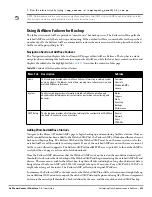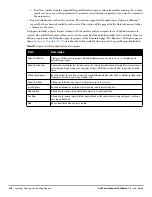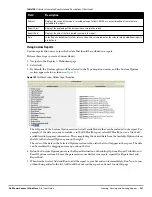
Dell PowerConnect W-AirWave 7.4
| User Guide
Performing Daily Administration in AirWave |
219
Table 123
System > Performance Page Fields and Graphs
Field
Description
System Information
CPU(s)
Basic CPU information as reported by the operating system.
Memory
The amount of physical RAM and Swap space seen by the operating system. Refer to the
AirWave Server Hardware Guide
at
support.dell.com/manuals
for hardware requirements.
Kernel
The version of the Linux kernel running on the box.
Architecture
The AMP’s architecture information.
Device Polling
Displays some AP/Device polling statistics.
Performance Graphs
System Load Average
The number of jobs currently waiting to be processed. Load is a rough metric that will tell you
how busy a server is. A typical AirWave load is around 2-3 times the number of CPU cores you
have in your system. A constant load of 4x to 5x is cause for concern. A load above 6x is a
serious issue and will probably result in AirWave becoming unusable. To lower the load average,
try increasing a few polling periods in the Groups > Basic page.
System Memory Usage
The amount of RAM that is currently used broken down by usage. It is normal for AirWave to
have very little free RAM. Linux automatically allocates all free RAM as cache and buffer. If the
kernel needs additional RAM for process it will dynamically take it from the cache and buffer.
System Disk Utilization
The amount of data read from the disk and written to the disk.
System Disk IOPs
The number of disk reads and writes per second.
System Disk Throughput
The rate of reading and writing from and to the disk in bytes per second.
System Disk Outstanding I/O
Requests
The average number of outstanding I/O requests (queue depth). If it's high, it means that I/O
requests (disk reads/writes) aren't being serviced as fast as they're being asked for.
System Swap Usage
The amount of Swap memory used by AirWave. Swap is used when the there is no more free
physical RAM. A large performance penalty is paid when swap is used. If an AirWave
consistently uses swap, you should consider installing additional RAM.
System CPU Utilization
The percentage of CPU that has been used by the user and the system as well as the amount
that was idle.
I/O Throughput by Worker/by
Service
Displays reads and writes for workers (AMP services, database, VisualRF, web server, RRD tool
and AWRRD tool) and for services (AMP, VisualRF and web server).
CPU Utilization by Worker/by
Service
Displays reads and writes for workers (AMP services, database, VisualRF, web server, RRD tool
and AWRRD tool) and for services (AMP, VisualRF and web server).
System Network Bandwidth
All traffic in and out measured in bits per second of your primary network interface (Eth0 being
the most common).
Bandwidth by Protocol
Displays the amount of traffic used by Telnet, HTTPS and SNMP used by your primary network
interface (Eth0 being the most common).
Legacy SNMP Fetcher
Requests
The number of SNMP get and walk requests per second performed by the legacy (v1 and v3)
SNMP fetcher.
Legacy SNMP Fetcher
Responses
The number of SNMP OIDs received per second performed by the legacy (v1 and v3) SNMP
fetcher.
High Performance SNMP
Fetcher Requests
The number of SNMP get and walk requests per second performed by the high performance
SNMP (v2c) fetcher.
High Performance SNMP
Fetcher Responses
The number of SNMP OIDs received per second performed by the high performance SNMP
(v2c) fetcher.
Содержание PowerConnect W-Airwave
Страница 1: ...Dell PowerConnect W AirWave 7 4 User Guide ...
Страница 106: ...106 Configuring and Using Device Groups in AirWave Dell PowerConnect W AirWave 7 4 User Guide ...
Страница 256: ...256 Creating Running and Emailing Reports Dell PowerConnect W AirWave 7 4 User Guide ...
Страница 310: ...310 Index Dell PowerConnect W AirWave 7 4 User Guide ...
















































